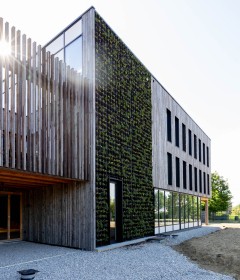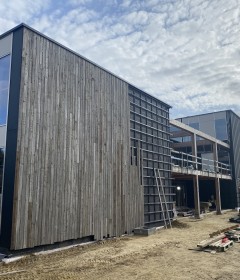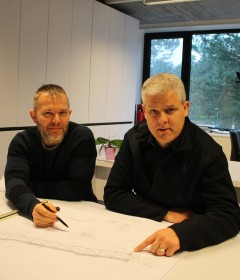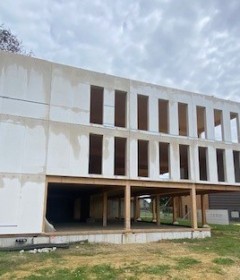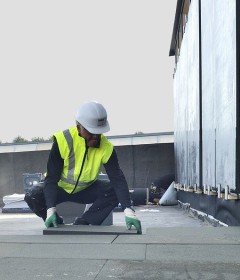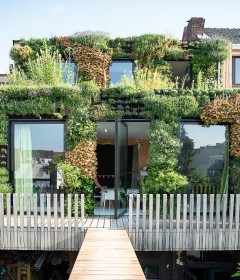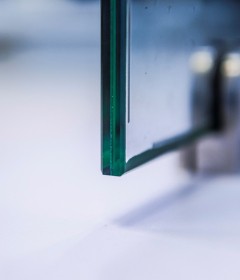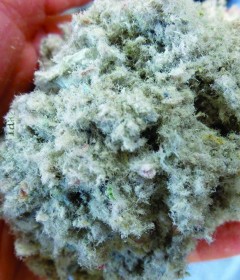30 september 2021
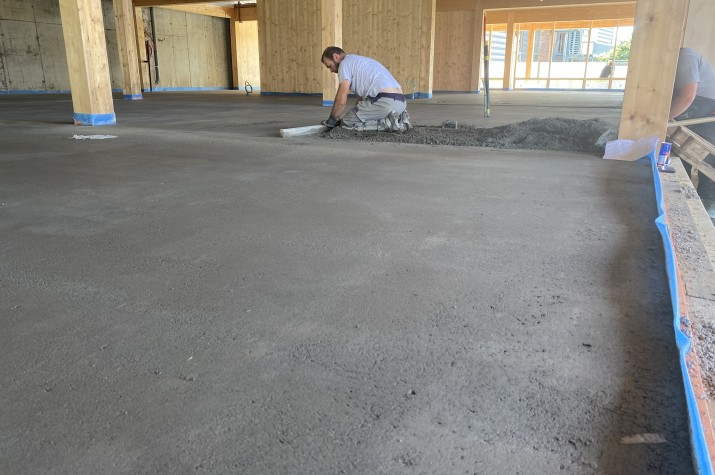
Cementless screed was used in 't Centrum. This is a new circular screed. The screed consists of reclaimed sand from construction and demolition waste, street sand and sand from sewers. Wouter Cementless screed was used throughout ‘t Centrum. This is a new circular screed, made from reclaimed Vermin, Manager Treatment & Valorisation at Bioterra, explains what this means.
What is cementless screed?
Wouter Vermin: “As its name implies, this screed does not contain any cement.
The sand, which is 100% recycled, is bound with a ‘new’ lime-based binder. Besides lime, this binder contains hydrating residual streams and a natural starter.
The recipe was developed by Greenager +; Bioterra NV is the producer of the high-quality recycled granulate 0-4 mm.”
What makes this screed circular and why did you choose to use it in ‘t Centrum?
Wouter Vermin: “The sand is 100% circular and was recovered from construction and demolition waste, street sand and sand from sewers. So this sand has already had a first life, unlike conventional screeds, which are made from 100% virgin material, meaning materials that have not been previously used or processed. Primary raw materials are under increasing pressure every day, which is why this unique screed that is made from 100% recycled materials offers a perfect alternative.
- The binder is partly made up of residual streams, supplemented with natural lime.
The main difference between lime and cement is that lime can be reused several times at end of life.
Additional lime must be added if it has been ground or will be reused in order to obtain a fully-fledged, high-quality product. So it’s not 100% circular for now but we are working on it.”
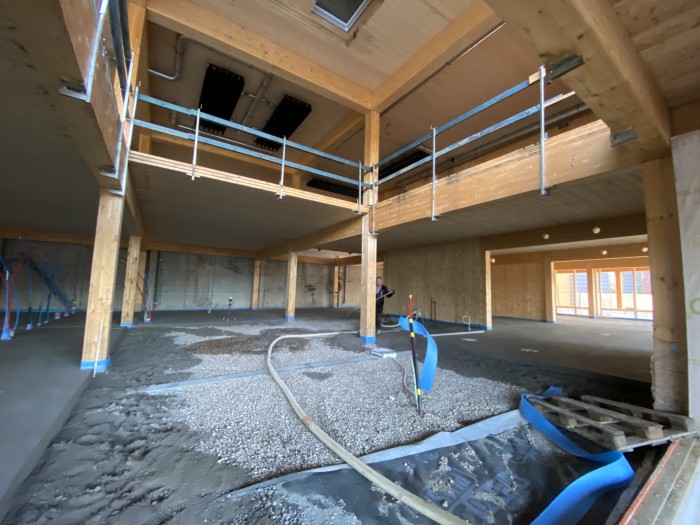
What is the end-of-life scenario for this screed?
Wouter Vermin: “Recycled materials are recycled and reused again. Unlike cement, lime can be reused. The second and possibly even third life of the materials used has already been examined and has been found to be positive.”
What (circular) advantages does cementless screed offer?
Wouter Vermin: “The base consists of several types of recycled sand as a filler.
This is combined with a binder that is also sourced from residual streams with a hydrating effect on the entire mixture. We then supplement this with natural lime. At end of life, everything is recycled into raw material for reuse.”
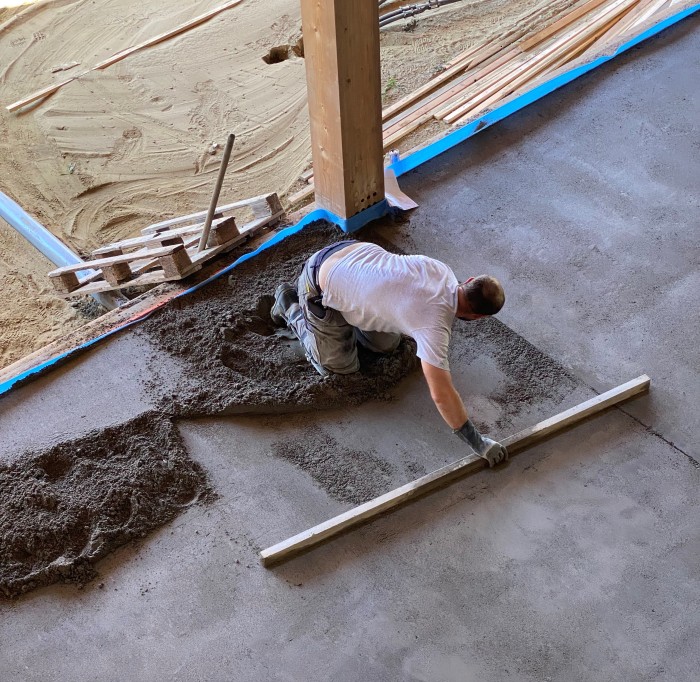
How is this screed applied? Which floor substrate is suitable for this?
Wouter Vermin: “This screed is applied in the same way as a conventional sand/cement screed.
Because the specific weight of lime and the hydrating particulate matter is lower than that of cement, more paste can be produced with the same amount of binder. The end product is therefore slightly greasier, sealing the surface better and making it more wear-resistant.
For this reason, we recommend that this screed is lightly polished which only serves to improve its quality. The installer of the floor will also have to use less force when finishing it, improving working comfort.
In terms of substrate, there is no real difference compared with conventional screed. Our screed does have a longer drying time, however. But this reduces the risk of cracks, which is actually an advantage”.
Did the preparation (composition) and the installation in ‘t Centrum go as smoothly as would have been the case with conventional cement-bound screed? What are some points for attention?
Wouter Vermin: “It’s safe to say that installers won’t notice much of a difference. But you know what they say, unknown is unloved. The first time you always need to determine the right amount of water and excipient. But this is also the case when a manufacturer switches to another type of sand or cement. Compared with new sand, this sand is specially developed from multiple types of recycled sand to arrive at a suitable and constant grain size distribution.
There are some points for attention, however:
- For the processor: this binder (lime) requires more water.
- For the recycler: prevent coarse materials on-site (e.g., stones) from finding their way into the sand because the pump may become obstructed as a result (this has already happened at ‘t Centrum).”
Does this screed have the same technical properties and are the screed thicknesses identical to conventional screeds?
Wouter Vermin: “Currently we are still in the pilot test phase. We don’t have all the information yet.
For now we assume that this screed only has advantages:
- The risk of cracks is smaller because it takes longer to cure.
- When combined with underfloor heating, this screed heats up faster, retaining heat for longer. The sand is up to 15% heavier and therefore contains more mass. The relevant studies will be started up imminently.
For now, we assume that the screed thicknesses are the same as those of conventional screed. The minimum thickness still has to be determined. For the sake of completeness, we would also like to state that this screed is always reinforced as standard. We use a natural vegetable fibre (carbon neutral) for this, made from a plant called kenaf.
At the moment, our screed is still slightly more expensive than conventional screed, but we expect this will soon be a thing of the past in view of rising cement prices. You also have to factor in the residual value when you’re looking at price.
In an end-of-life situation, i.e. when this screed is demolished, it can be recycled for the same application. A classic cement screed that is broken up often ends up among the stones at a crushing plant and will be used for lower grade applications.”
Materials exhibit
The floor in the circulation areas of ‘t Centrum will be finished with loose tiles with a cork underlay. The office areas will be finished with reclaimed carpet tiles. ‘t Centrum will use circular techniques and materials where possible, essentially making it a materials exhibit.
Get in touch with Wouter.Vermin@bioterra.be to find out more about the screed that was used at ‘t Centrum.
Photos: © Joeri Beneens

